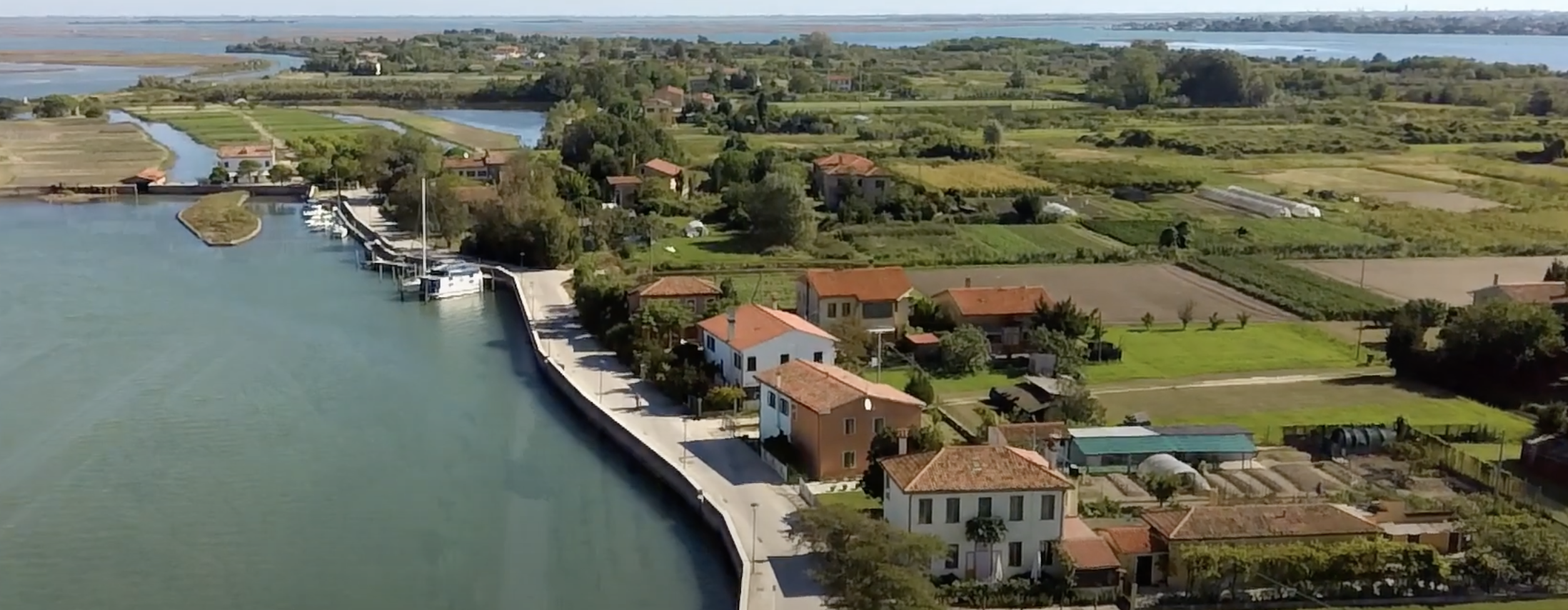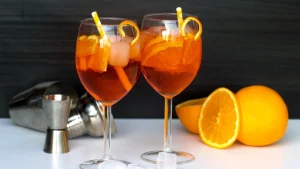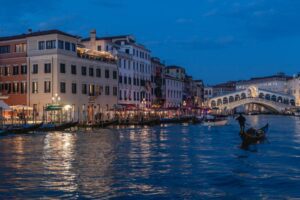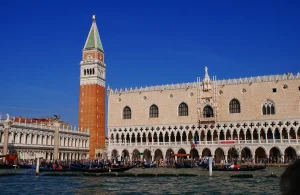Venice isn’t just a destination — it’s a miracle. A city that floats on more than a hundred small islands, built on wooden piles driven into mud centuries ago, where canals replace roads and palaces shimmer on the water’s surface. But this beauty comes with fragility.
Rising sea levels, mass tourism, and a shrinking local population have made Venice one of the most vulnerable cities in the world. Every year, the balance between life and preservation grows more delicate.
So if you’ve ever asked yourself, “How can I visit Venice without harming it?” — congratulations, you’re already part of the solution.
Sustainable travel in Venice doesn’t mean giving up joy or comfort. It means choosing experiences that respect the lagoon, empower locals, and protect the culture that makes Venice one of a kind.
In this guide, we’ll show you exactly how to do that — where to stay, what to eat, how to move around, what to buy, and which tours to join. Every small decision can make a big difference.
🌊 1. Understanding Venice’s Challenges
To travel responsibly, we first need to understand what Venice is facing. Its problems aren’t simple — they’re intertwined, shaped by tourism, economics, and the environment.
Overtourism
Venice welcomes over 20 million visitors each year, many of them day-trippers from cruise ships or buses. Crowds strain narrow alleys, bridges, and fragile infrastructure. The city wasn’t designed for this scale of mass tourism.
Population Decline
The historic center’s population has dropped from 175,000 in the 1950s to fewer than 50,000 today. Rising housing costs, limited jobs, and tourist pressure push Venetians to the mainland. Every family that leaves takes a piece of Venice’s soul with them.
Environmental Pressures
Cruise ship emissions, plastic waste, and acqua alta (high water) threaten both the lagoon and daily life. Even though the MOSE barrier helps protect against floods, climate change continues to challenge the city’s resilience.
Cultural Erosion
Mass-produced souvenirs and short visits overshadow authentic crafts and traditions. True Venetian artistry — like Murano glass, mosaic art, or mask-making — survives only when visitors choose authenticity.
By being aware of these challenges, you can adapt how you travel — and transform your trip from simple sightseeing into genuine preservation.
🚶♀️ 2. Stay Longer, Travel Slower
The best gift you can give Venice? Your time.
Many visitors arrive for just a few hours, racing from Piazza San Marco to the Rialto Bridge before returning to their ship or train. These fleeting visits bring crowds but little economic benefit to locals.
Instead, choose to stay — to linger. Venice rewards slowness.
- Stay overnight or several nights. You’ll see Venice at its most beautiful — early mornings when locals open shop, and evenings when canals reflect the moonlight.
- Explore beyond the postcard. Wander through Cannaregio, Castello, or Dorsoduro — where artisans still live and work.
- Connect with locals. Join an off-the-beaten-path walking tour, or share stories with shopkeepers in family-run osterie.
Slow travel means fewer crowds, deeper experiences, and more meaningful support for Venice’s community.
🏨 3. Where to Stay: Support the Local Community
Your accommodation choice can either help or hurt Venice — here’s how to make it count.
- Choose family-run hotels or guesthouses. Staying in a locally owned property keeps money circulating within the community instead of leaving it in corporate hands.
- Pick boutique hotels in restored palazzi. Many focus on sustainability and heritage preservation — offering comfort with conscience.
- Avoid unlicensed short-term rentals. Illegal listings push residents out. Always verify that your stay is registered with the city.
And when you sleep inside the historic center, you reduce daily commuting and help Venice remain a living city — not just a daytime attraction.
🚤 4. Getting Around Venice the Sustainable Way
Venice is the ultimate car-free city. No engines, no horns — just boats and footsteps echoing between walls. But even here, there’s room for more sustainable choices.
- Walk whenever you can. You’ll see the city’s details — laundry lines, hidden courtyards, local markets — and reduce strain on public transport.
- Use vaporetti (waterbuses) for longer routes or when visiting the islands.
- Take a traditional gondola ride — it’s part of Venice’s heritage, not just a photo op. Each gondolier maintains a craft passed down through generations.
- Avoid private motorboats unless necessary. Their waves (called moto ondoso) damage ancient foundations.
For an authentic and eco-friendly twist, try our Venetian Rowing Experience — where you’ll learn to row standing up, like true locals do.
🍝 5. Eating Responsibly: Taste Venice Without Waste
Venetian cuisine is built on simplicity, seasonality, and sustainability — long before those became trendy words.
- Eat local. Try classic dishes like sarde in saor, baccalà mantecato, or bigoli in salsa.
- Support family-run trattorie over tourist buffets. They buy ingredients from local markets and serve recipes passed down for generations.
- Drink Venetian wines — like Prosecco Superiore DOCG from Asolo (visit our Adopt a Vineyard experience).
- Skip plastic bottles. Bring a reusable one — Venice’s public fountains pour fresh, drinkable water.
- Avoid chains. Global fast-food spots drain the city’s character and economy.
Every meal can be an act of preservation when you choose authentic flavors over convenience.
🎭 6. Shopping: From Plastic Masks to True Artisans
Souvenirs tell stories — make sure yours tell the right one.
Many shops sell cheap, imported trinkets. They may look Venetian, but they have nothing to do with the city’s artistry.
- Buy from real artisans. Visit workshops on Murano, create your own glass bead, or learn mask-making in Venice.
- Look for authenticity seals — “Vetro Artistico® Murano” ensures your glass is genuine.
- Choose experiential souvenirs — join a hands-on workshop instead of buying another fridge magnet.
When you buy directly from artisans, you help sustain families and keep centuries-old skills alive.
🤝 7. Respect Local Life
Venetians live here — and daily life in a city of canals is no small feat. Respect is the foundation of responsible travel.
- Don’t block bridges or narrow alleys for photos.
- Dispose of waste properly — recycling is strictly enforced.
- Dress appropriately when entering churches or sacred sites.
- Don’t picnic on monuments or church steps — enjoy parks or designated areas instead.
- Learn a few Italian words — “buongiorno,” “grazie,” or “permesso” make a big difference.
Venice opens up to those who respect it. Be a guest, not just a visitor.
🌅 8. Eco-Friendly Day Trips from Venice
The Veneto region offers incredible day trips that spread tourism beyond the center — easing pressure on the city while enriching your experience.
- Murano & Burano: Visit authentic glass and lace workshops with our Private Island-Hopping Excursion.
- Mazzorbo & Torcello: Explore vineyards and ancient churches on a Slow Lagoon journey.
- The Prosecco Hills: Visit boutique wineries on our Prosecco Hills Tour, a UNESCO-protected landscape.
- Treviso or Bassano del Grappa: Discover slow food traditions, local markets, and artisans with From Venice With Love experiences.
Each trip supports regional families, diversifies income, and deepens your understanding of Venetian culture.
🌦️ 9. Venice and Climate Change: What Visitors Should Know
Venice is on the front line of climate change — a symbol for coastal cities worldwide. Rising sea levels and unpredictable weather already reshape the lagoon’s rhythm.
Here’s how travelers can help:
- Visit off-season — autumn and winter offer tranquility and balance crowd impact.
- Learn about MOSE and preservation projects to understand the city’s fight against the sea.
- Offset your carbon footprint through verified programs or by supporting lagoon restoration initiatives.
- Be mindful during acqua alta. It’s not just a photo op — it’s a reminder of what’s at stake.
When you understand the fragility of Venice, every responsible action becomes an act of love.
🗺️ 10. Private, Sustainable Tours With Local Guides
One of the most powerful ways to support Venice is by booking private tours with licensed local guides — not group tours.
- Local guides adapt tours to your interests and timing, avoiding crowds and reducing congestion.
- They connect you directly with artisans, workshops, and neighborhoods tourists rarely see.
- They turn sightseeing into cultural exchange — respectful, authentic, and unforgettable.
At Tour Leader Venice, every experience is private and purposeful — from Cicchetti & Wine Tours to private boat tours and rowing lessons. You’ll experience Venice like a local — without leaving a heavy footprint.
💚 Explore Private, Sustainable Tours in Venice →
🎉 11. Festivals and Events: Participate With Care
Venice’s festivals — from Carnevale to the Regata Storica and the Biennale — are not just spectacles; they’re living traditions. Joining them responsibly means celebrating without overwhelming.
- Carnevale: Buy authentic masks made by artisans, not plastic imports.
- Regata Storica: Watch respectfully and avoid blocking bridges or canals.
- Biennale: Support Venice’s role as a global art capital — these events sustain the city’s creative heartbeat.
Participate, don’t dominate — and you’ll leave with memories, not consequences.
🧭 12. Quick Checklist for Responsible Visitors
- Carry a reusable water bottle.
- Bring a fabric tote for shopping.
- Refuse plastic straws and cutlery.
- Respect quiet hours and residential zones.
- Explore beyond San Marco — try Sant’Elena, Giudecca, or San Pietro di Castello.
Small gestures, multiplied by thousands, make a city stronger.
💬 Conclusion — Be Part of Venice’s Future
Venice has survived empires, floods, and pandemics — but its most fragile moment may be now. The challenge isn’t just rising water; it’s sustaining a living community within a global attraction.
As travelers, we have the power to shape that future. By choosing private, responsible, and authentic experiences, we protect what makes Venice eternal — its people, its art, and its soul.
When you leave, ask yourself: Did I give back as much as I received? If the answer is yes, you’ve become part of Venice’s story — not just a visitor, but a guardian.
🌍 Travel Responsibly — Discover the Real Venice With Tour Leader Venice →
How can I visit Venice responsibly?
Choose to travel slower and stay longer. Book private tours with licensed Venetian guides, support local artisans instead of souvenir chains, and eat in family-run trattorie that use seasonal ingredients. Walk or use vaporetti, carry a reusable bottle, and respect residential quiet zones. Every small gesture helps Venice remain a living city. Explore our Off-the-Beaten-Path Private Walking Tour to experience authentic neighborhoods the sustainable way.
What are the most eco-friendly experiences in Venice?
Opt for low-impact activities that celebrate tradition — like learning to row a Venetian boat on our Venetian Rowing Experience, joining a Cicchetti & Wine Tour, or creating art in a Murano glass or mask-making workshop. These experiences directly support artisans and protect centuries-old crafts.
Is Venice really sustainable to visit?
Yes — when you travel consciously. Staying overnight, avoiding mass day-trips, and supporting local guides, workshops, and eco-tours make your visit part of the solution. Tour Leader Venice designs Slow Lagoon Experiences and private transfers that minimize environmental impact while helping preserve the lagoon’s fragile ecosystem.







